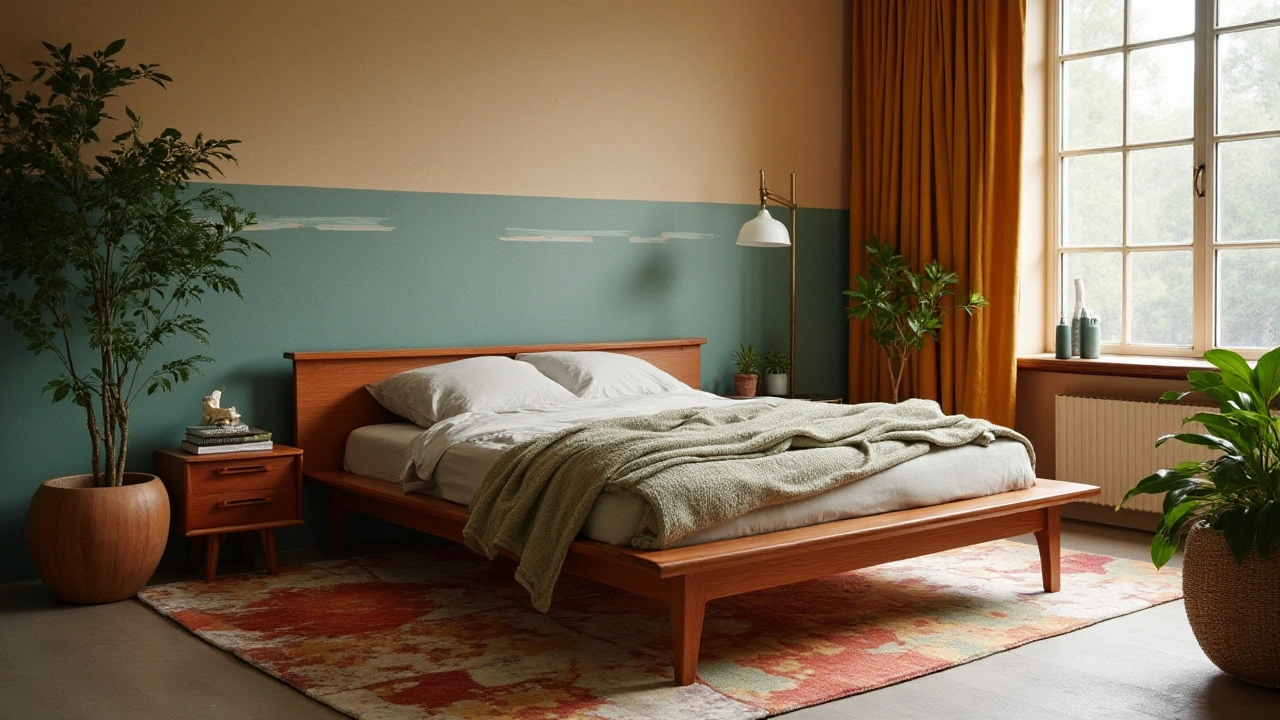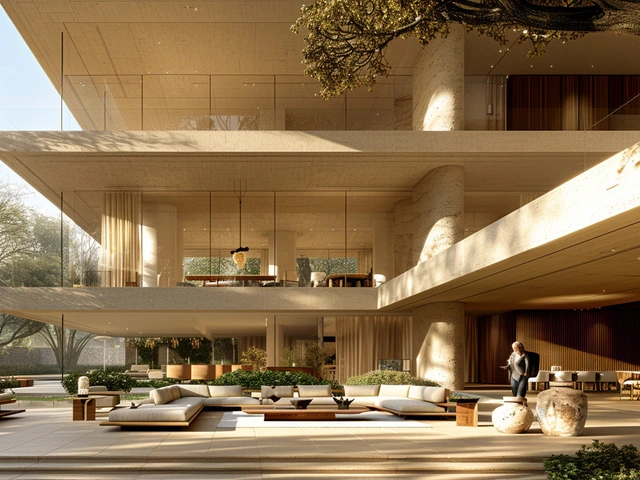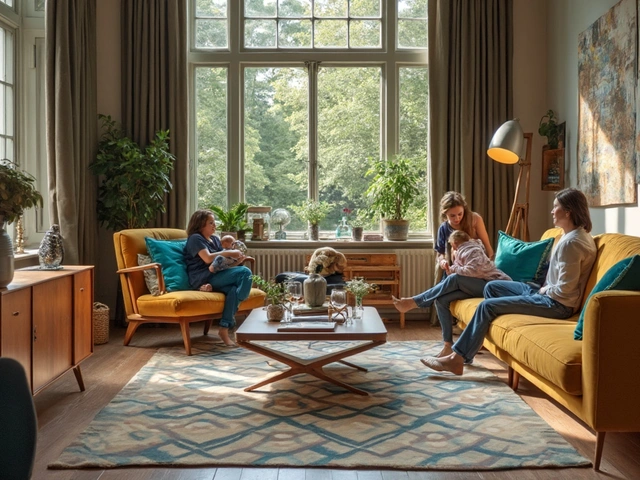Mid-century modern design is a timeless style that has captured the hearts of design enthusiasts around the globe. Rooted in the mid-20th century, this aesthetic emphasizes simplicity, functionality, and a connection to nature.
The style is characterized by clean lines, organic forms, and minimal ornamentation. Furniture pieces often feature natural materials, such as wood and leather, and are designed to serve both form and function.
Whether you're a seasoned aficionado or a curious newcomer, this guide will walk you through the essentials of mid-century modern design. From its fascinating history to the key elements that define this style, you'll learn how to bring a touch of retro elegance into your own space.
- History and Origins
- Key Elements
- Iconic Furniture Pieces
- Color Palettes and Materials
- Incorporating Mid-Century Modern in Your Home
History and Origins
Mid-century modern design, often referred to as Mid-century, is a design movement that became popular roughly between the mid-1940s and the late 1960s. This period was marked by a post-World War II era of optimism and rapid technological advancement. The design style emerged as a reaction to the ornate, elaborate styles of the previous era, embracing simplicity and functionality.
The roots of this design movement can be traced back to the Bauhaus and International Style, which advocated for minimalist design and functionality. When the Bauhaus school closed in 1933 due to Nazi pressure, many of its key figures, such as Mies Van Der Rohe and Marcel Breuer, migrated to the United States and brought their design philosophies with them, significantly influencing American architecture and design.
The post-war boom in the United States created a demand for new and affordable housing, which in turn spurred a need for well-designed, functional furniture. Designers like Charles and Ray Eames, Eero Saarinen, and George Nelson became household names, their creations reflecting the ethos of mid-century modern: clean lines, organic shapes, and new materials like molded plywood, plastic, and aluminum.
In addition to residential architecture and furniture, mid-century modern design also found its way into office spaces and public buildings. Architect Ludwig Mies Van Der Rohe's Farnsworth House and Le Corbusier's Chandigarh in India are iconic examples of how mid-century design principles were applied to more public-oriented projects. These buildings showcase the use of open spaces, large windows, and integration with the surrounding environment.
The movement also placed a strong emphasis on integrating the indoors with the outdoors. Sliding glass doors, large windows, and the use of natural materials created a seamless transition between home interiors and the natural world outside. This philosophy was rooted in the belief that living spaces should be an extension of the natural environment, fostering a sense of well-being and connectivity for their inhabitants.
By the late 1960s, mid-century modern design began to wane in popularity as new movements like postmodernism emerged. However, the practical yet stylish designs of this era never truly went out of style. The early 2000s saw a resurgence in interest, fueled by a growing appreciation for vintage aesthetics and DIY home decor. Today, mid-century modern design remains a popular choice for those looking to blend the past with the present in a sophisticated way.
"The mid-century modern approach is not about creating period rooms but about understanding the principles of this design movement and interpreting them for contemporary living," says architect and interior designer, Emily Bills.
Understanding the origins and history of mid-century modern design provides valuable context for appreciating its lasting influence. Whether you're a design aficionado or simply curious, delving into this rich history opens up a world of inspiration and timeless beauty.
Key Elements
Mid-century modern design stands out due to its hallmark features, making it an easy-to-recognize yet versatile style. One of the most significant aspects is its emphasis on clean, simple lines. This is often seen in furniture pieces that boast no-frill lines and uncluttered silhouettes. Whether it's a sleek wooden dining table or a minimalist sofa, the design prioritizes clarity and function over ornate detailing.
Another defining element is the integration of organic and geometric shapes. Curved lines and smooth surfaces are frequently paired with more rigid and angular components, creating a harmonious balance. Imagine a circular coffee table next to a rectangular sectional—the interplay of different shapes adds visual interest without overwhelming the space. Speaking of materials, mid-century modern loves natural ones. Wood, especially teak, walnut, and oak, takes the center stage. These materials lend a warm, grounded feeling to the space.
An interesting fact about mid-century modern design is its relationship with the outdoors. Large glass windows, patio doors, and open-plan layouts are designed to blur the line between indoor and outdoor living. The idea is to bring nature inside and let the interior breathe. Light plays a vital role here, illuminating spaces to appear airier and more expansive. This concept ties into biophilic design principles that emphasize the human connection to nature.
When it comes to colors, the style favors earthy tones, paired with bold accent colors. Neutral shades like beige, gray, and cream form the backdrop, complemented by striking hues like teal, orange, or mustard. These bold pops of color often appear in fabrics, artwork, or small decor items. It's a tasteful way to inject personality without making the space feel chaotic.
Bold patterns and textures are also notable. Think geometric prints or abstract art that adds a lively touch. However, balance is key. If you're opting for vibrant wallpaper or a statement rug, keep the surrounding areas neutral to maintain harmony. Textures like leather, tweed, and velvet provide a lush feel, adding layers to the overall aesthetic.
A major takeaway from mid-century modern design is to embrace simplicity and functionality while letting personal style seep through in small but impactful ways. It's not about filling every inch but about choosing meaningful pieces that serve both an aesthetic and practical purpose. As famed designer Charles Eames once said,
"The details are not the details. They make the design."So, while you appreciate the overarching elements, don't forget the smaller touches that make a house truly a home.
Iconic Furniture Pieces
When we think of mid-century modern design, certain furniture pieces immediately come to mind. These pieces have stood the test of time and are still celebrated today for their innovation and style. They are not just functional; they are works of art.
First on the list is the Eames Lounge Chair and Ottoman, designed by Charles and Ray Eames in 1956. This chair is the epitome of mid-century modern comfort and luxury. It features molded plywood and leather, combining natural materials with an elegant design. This chair has been a fixture in homes and offices, making it an enduring symbol of the mid-century modern movement.
Another standout piece is the Noguchi Coffee Table, designed by Isamu Noguchi in 1948. This table is famous for its unique, organic shape. It features a glass top and two interlocking wood pieces that create a sculptural form. Noguchi's background as a sculptor is evident in this design, which blurs the lines between art and furniture.
The Egg Chair, designed by Arne Jacobsen in 1958, is another iconic mid-century modern piece. Its futuristic design was initially created for the SAS Royal Hotel in Copenhagen. The chair's curved lines and sleek upholstery make it a standout piece in any room. It offers both comfort and style, embodying the essence of mid-century design.
Florence Knoll's Sofa, designed in 1954, perfectly balances form and function. The sofa's simple, clean lines and tailored upholstery make it a versatile piece that fits into any mid-century modern interior. Florence Knoll was a pioneer in the modern office design movement, and her furniture pieces are still highly sought after today.
For lighting, the Arco Floor Lamp, designed by Achille and Pier Giacomo Castiglioni in 1962, is iconic. It features a marble base and a long, curved arm that extends outwards to provide overhead light without needing ceiling fixtures. This lamp is both a functional light source and a sculptural piece of art.
"The best designs have a way of becoming part of our lives in a way that we don't even notice. They feel like they have always been there, like they are part of the natural order of things." - Charles Eames
The Barcelona Chair, designed by Ludwig Mies van der Rohe in 1929, is another must-mention. It's made of leather and chrome, and its sleek, minimal design epitomizes mid-century elegance. Originally made for the German Pavilion at the 1929 International Exposition in Barcelona, it remains a highly influential piece.
Finally, the Nelson Ball Clock, designed by George Nelson in 1949, adds a touch of whimsy and innovation to mid-century modern decor. Its playful design and bright colors make it a captivating wall piece.
These iconic furniture pieces are integral to the mid-century modern aesthetic. They embody the principles of simplicity, functionality, and beauty. These designs have not only shaped interior spaces for decades but have also influenced modern design in significant ways. When you incorporate these pieces into your home, you're not just adding furniture; you're integrating a piece of design history.
Color Palettes and Materials
When it comes to mid-century modern design, the color palette is usually understated but well thought out. Earthy tones like olive green and mustard yellow are commonly used, often mixed with rich, wooden hues and neutral colors such as white, black, and various shades of gray. These colors help to create a space that's cozy yet sophisticated, maintaining a seamless blend of comfort and style.
One of the key aspects of mid-century modern design is its emphasis on natural materials. You'll frequently see furniture crafted from teak, oak, and walnut. Leather and wool are also typical in upholstery, adding both durability and a sense of luxury to the pieces. These materials not only make the furniture long-lasting but also contribute to the warm, inviting look that's characteristic of this design style.
Textiles play a significant role as well. Geometric patterns, bold stripes, and even abstract designs can be found on cushions, rugs, and curtains. These patterns add a dynamic visual interest to the otherwise clean and simple lines that dominate the furniture and architecture. The juxtaposition of these elements brings a balanced yet visually stimulating environment.
Lighting is also crucial. Floor lamps and pendant lights with sleek, metallic finishes are common. These fixtures often feature tapered or splayed designs, aiming to complement the overall clean lines of the surrounding furniture. The right lighting not only focuses on functionality but also serves as eye-catching accessories that elevate the aesthetic quotient of the room.
To round out the decor, accessories made from natural materials like ceramic, glass, and metal are popular choices. These bring a level of sophistication and add more texture and contrast to the living space.
According to designer and historian Mark Hertzberg, "Mid-century design continues to be so relevant today because it provides a timeless look that feels modern and functional at the same time."
Lastly, don't forget the impact of greenery. Incorporating plants helps to enhance that indoor-outdoor link intrinsic to mid-century modern design. Large potted plants or hanging planters can bring in fresh, organic vibes, making the space feel more alive.

Incorporating Mid-Century Modern in Your Home
Bringing mid-century modern design into your home can be a rewarding and enjoyable project. This iconic style is known for its clean lines, functional furniture, and an overall sense of harmony and simplicity. Whether you are starting from scratch or adding elements to an existing décor, mid-century modern can transform any space into a stylish and inviting environment.
The first step is to focus on furniture. Pieces from the mid-century era are not only beautiful but also practical. Look for items like the Eames Lounge Chair or the Saarinen Tulip Table, known for their aesthetic appeal and comfort. These pieces often feature natural materials like wood and leather, which add warmth and character to your home. Don't be afraid to mix these classics with contemporary pieces to create a balanced and modern look.
Mid-century modern design loves open spaces and natural light. Large windows and open floor plans are a hallmark of this style. If you're renovating, consider opening up your living spaces to let in more light. If structural changes aren't an option, use mirrors and light-colored walls to brighten up the space. The goal is to create an airy, light-filled environment that feels both spacious and cozy.
Color plays a significant role in mid-century modern design. Think earthy tones like mustard yellow, olive green, and burnt orange, alongside neutral shades of white, black, and gray. These colors can be incorporated through furniture, walls, and accessories. A well-placed splash of color can bring vibrancy without overwhelming the space. Color palettes like these create a sense of continuity and flow, making your home feel more cohesive.
Accessories are the finishing touch. Iconic mid-century accessories include starburst clocks, geometric patterns, and abstract art. These elements add personality and flair while staying true to the style's principles. Houseplants are another great addition, as they bring in elements of nature, which was highly valued by mid-century designers. Choose plants with interesting shapes, like cacti or snake plants, to complement the clean lines of your furniture.
"The key to successfully incorporating mid-century modern design is balance. Don't go overboard on any single element—let the beauty of simplicity shine through," says Sarah Richardson, a respected interior designer.
Lastly, pay attention to the layout. Mid-century modern spaces are designed to be functional and flow naturally. Arrange your furniture in a way that promotes conversation and interaction. Avoid cluttering the space with too many items. Each piece should have a purpose and a place. The open, uncluttered feel of mid-century modern design not only looks great but also promotes a more relaxed and comfortable living environment.
Incorporating mid-century modern design into your home doesn't have to be daunting. By focusing on key elements such as furniture, light, color, and accessories, you can create a space that is both stylish and functional. Whether you are a seasoned interior design enthusiast or just starting out, mid-century modern offers a timeless and versatile aesthetic that can work in any home.





